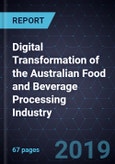The Start of a Paradigm Shift
Market estimates, growth estimates, and segmentation are based on existing data, secondary research, and information gathered from interviews in 2018. The base year for the report is 2017. The beverages subsegment is the most digitally mature end market in the F&B sector, followed by meat and dairy. Maturity varies between the subsegments according to process complexity and availability/accessibility of data. While the competitive market is mainly dominated by large multinational companies, small niche solution providers are also active in the industry.
Apart from the large and established farming sector that provides input to the processing sector, Australia’s food and beverage processors also enjoy other competitive advantages. The geographical proximity to Asia offers a strategic opportunity for Australian food and beverage processors. The similar time zone, free trade agreements, and shipment routes offer profitable and sustainable opportunities to expand Australia’s export of food and beverage products. In this context, the country’s global reputation as a supplier of ‘clean-green’ processed food and beverage products is also a significant advantage. Rising input costs, such as electricity, gas, and transport, are pushing up operating costs for a range of food and beverage processors in the country.
There is also an increase in the market’s competitive intensity that drives product variety and differentiation. Given downward price pressure from large retailers, food processors are seeking to differentiate their offerings by increasing the range of products they can deliver to market.
Consumers are looking for transparency and traceability when they purchase their food.
There are many reasons for this trend: safety concerns, compliance with ethical standards, and reduction in food wastage.
While the initial investment for digital solutions may be high, they could progressively lead to reductions in: redundant manpower, material purchases, wastage and assembly processes that may incur unneeded costs.
Collaborative robots are designed to share the workspace with human workers, managing repetitive, mundane tasks to improve efficiency, while smart automated robots eliminate labor costs and human error.
Data analytics and IIoT encourage manufacturers to pinpoint areas of weakness and how best to improve them.
Cloud technology progressively eliminates the need for on-site IT maintenance and staff support. IT services are instantly available on a pay-per-subscription basis and accessible anywhere with a connection. However, advanced machinery that enables automation and other ICT solutions in manufacturing typically requires considerable capital investment. State-of-the-art ‘Connected Factories’ require a diverse range of sensors and advanced connectivity infrastructure, necessitating high initial investment.








